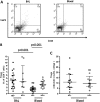Bronchoalveolar CD4+ T cell responses to respiratory antigens are impaired in HIV-infected adults
- PMID: 21357587
- PMCID: PMC3088469
- DOI: 10.1136/thx.2010.153825
Bronchoalveolar CD4+ T cell responses to respiratory antigens are impaired in HIV-infected adults
Abstract
Rationale: HIV-infected adults are at an increased risk of lower respiratory tract infections. HIV infection impairs systemic acquired immunity, but there is limited information in humans on HIV-related cell-mediated immune defects in the lung.
Objective: To investigate antigen-specific CD4(+) T cell responses to influenza virus, Streptococcus pneumoniae and Mycobacterium tuberculosis antigens in bronchoalveolar lavage (BAL) and peripheral blood between HIV-infected individuals and HIV-uninfected Malawian adults.
Methods: We obtained BAL fluid and blood from HIV-infected individuals (n=21) and HIV-uninfected adults (n=24). We determined the proportion of T cell subsets including naive, memory and regulatory T cells using flow cytometry, and used intracellular cytokine staining to identify CD4(+) T cells recognising influenza virus-, S pneumoniae- and M tuberculosis-antigens.
Main results: CD4(+) T cells in BAL were predominantly of effector memory phenotype compared to blood, irrespective of HIV status (p<0.001). There was immune compartmentalisation with a higher frequency of antigen-specific CD4(+) T cells against influenza virus, S pneumoniae and M tuberculosis retained in BAL compared to blood in HIV-uninfected adults (p<0.001 in each case). Influenza virus- and M tuberculosis-specific CD4(+) T cell responses in BAL were impaired in HIV-infected individuals: proportions of total antigen-specific CD4(+) T cells and of polyfunctional IFN-γ and TNF-α-secreting cells were lower in HIV-infected individuals than in HIV-uninfected adults (p<0.05 in each case).
Conclusions: BAL antigen-specific CD4(+) T cell responses against important viral and bacterial respiratory pathogens are impaired in HIV-infected adults. This might contribute to the susceptibility of HIV-infected adults to lower respiratory tract infections such as pneumonia and tuberculosis.
Conflict of interest statement
Figures






Similar articles
-
HIV-1 Infection Is Associated with Depletion and Functional Impairment of Mycobacterium tuberculosis-Specific CD4 T Cells in Individuals with Latent Tuberculosis Infection.J Immunol. 2017 Sep 15;199(6):2069-2080. doi: 10.4049/jimmunol.1700558. Epub 2017 Jul 31. J Immunol. 2017. PMID: 28760884 Free PMC article.
-
Asymptomatic HIV-infected individuals on antiretroviral therapy exhibit impaired lung CD4(+) T-cell responses to mycobacteria.Am J Respir Crit Care Med. 2014 Oct 15;190(8):938-47. doi: 10.1164/rccm.201405-0864OC. Am J Respir Crit Care Med. 2014. PMID: 25225948 Free PMC article.
-
HIV-1 infection impairs the bronchoalveolar T-cell response to mycobacteria.Am J Respir Crit Care Med. 2009 Dec 15;180(12):1262-70. doi: 10.1164/rccm.200907-1011OC. Epub 2009 Sep 24. Am J Respir Crit Care Med. 2009. PMID: 19797156 Free PMC article.
-
[Deep lung--cellular reaction to HIV].Rev Port Pneumol. 2007 Mar-Apr;13(2):175-212. Rev Port Pneumol. 2007. PMID: 17492233 Review. Portuguese.
-
CD4(+) T-cell subsets and host defense in the lung.Immunol Rev. 2013 Mar;252(1):156-63. doi: 10.1111/imr.12030. Immunol Rev. 2013. PMID: 23405903 Free PMC article. Review.
Cited by
-
Multifunctional CD4 T cell responses in patients with active tuberculosis.Sci Rep. 2012;2:216. doi: 10.1038/srep00216. Epub 2012 Jan 10. Sci Rep. 2012. PMID: 22355730 Free PMC article.
-
MR1-Restricted MAIT Cells From The Human Lung Mucosal Surface Have Distinct Phenotypic, Functional, and Transcriptomic Features That Are Preserved in HIV Infection.Front Immunol. 2021 Apr 9;12:631410. doi: 10.3389/fimmu.2021.631410. eCollection 2021. Front Immunol. 2021. PMID: 33897687 Free PMC article.
-
Regulation of naturally acquired mucosal immunity to Streptococcus pneumoniae in healthy Malawian adults and children.PLoS One. 2012;7(12):e51425. doi: 10.1371/journal.pone.0051425. Epub 2012 Dec 17. PLoS One. 2012. PMID: 23284694 Free PMC article.
-
Experimental human pneumococcal carriage augments IL-17A-dependent T-cell defence of the lung.PLoS Pathog. 2013 Mar;9(3):e1003274. doi: 10.1371/journal.ppat.1003274. Epub 2013 Mar 28. PLoS Pathog. 2013. PMID: 23555269 Free PMC article.
-
COVID-19 severity associates with pulmonary redistribution of CD1c+ DCs and inflammatory transitional and nonclassical monocytes.J Clin Invest. 2020 Dec 1;130(12):6290-6300. doi: 10.1172/JCI140335. J Clin Invest. 2020. PMID: 32784290 Free PMC article. Clinical Trial.
References
-
- Mathers C, Boerma T, Ma Fat D. The Global Burden of Disease: 2004 Update. Geneva, Switzerland: World Health Organisation, 2008
-
- Mukadi YD, Maher D, Harries A. Tuberculosis case fatality rates in high HIV prevalence populations in sub-Saharan Africa. AIDS 2001;15:143–52 - PubMed
-
- Turner D. Improving Global Health by Preventing Pneumococcal Disease. In: APPG , ed. London, United Kingdom: UK Government, 2008:1–35
-
- UNAIDS AIDS Epidemic Update: November 2009. Geneva, Switzerland: UNAIDS WH0, 2009
-
- van der Poll T, Opal SM. Pathogenesis, treatment, and prevention of pneumococcal pneumonia. Lancet 2009;374:1543–56 - PubMed
Publication types
MeSH terms
Substances
Grants and funding
LinkOut - more resources
Full Text Sources
Medical
Research Materials
